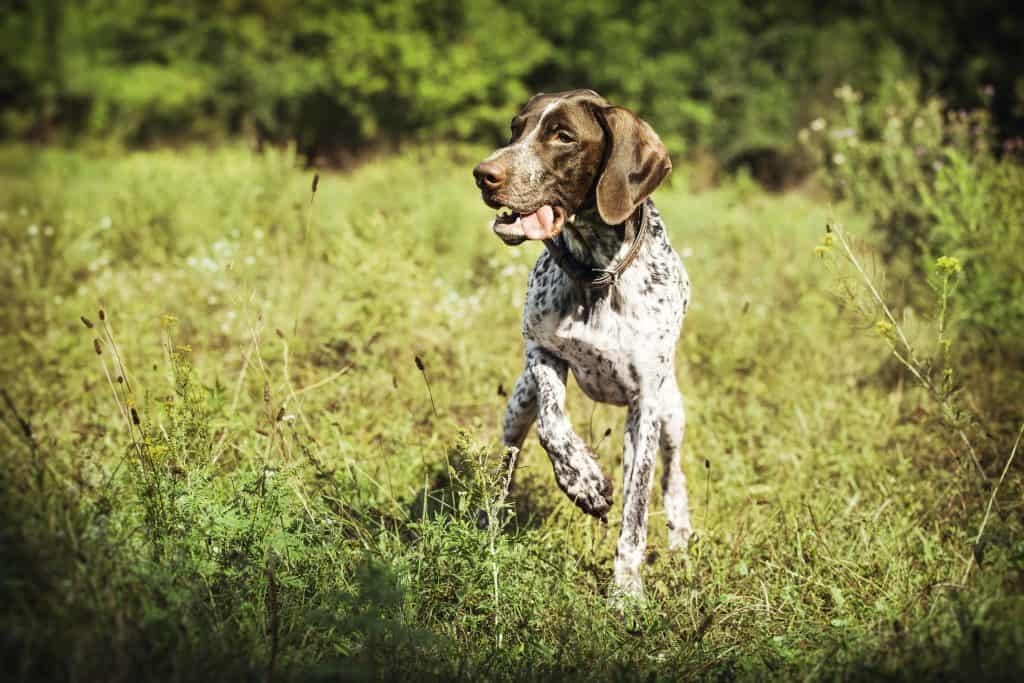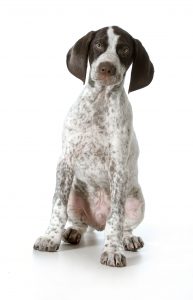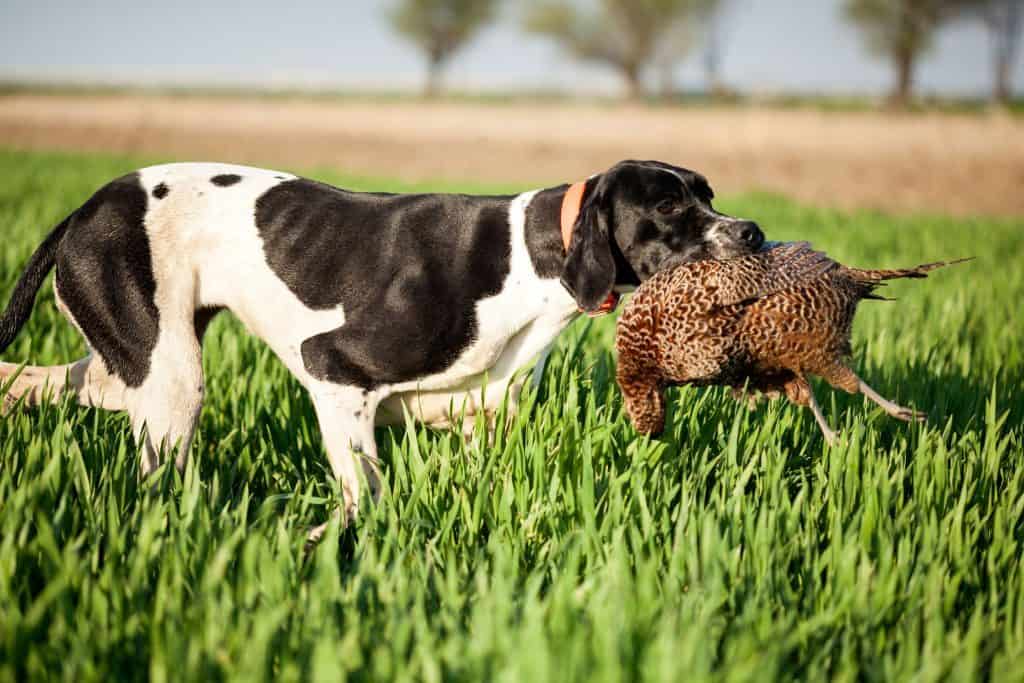Are Pointers Easy to Train?

Pointers are no exception to the understood rule that dog training is hard work. Training this breed takes time and patience to get right, but once it’s done, it’s well worth the effort.
Pointers are stubborn, easily distracted, and excitable so new dog owners may find it more difficult to train their pointer if they don’t know what they’re doing. Pointers are easier to train at as puppies and if the owner is patient and consistent.
Understanding how to train your pointer will go a long way into making the process easy and enjoyable. Knowing how your pointer thinks and behaves will help you utilize important commands for your pointer to be everything you hoped he or she would be.
Training Pointers
Training a pointer is not easy in the sense that it takes time and consistency. It is not going to be something that is accomplished in one week.
However, it isn’t hard if you have the time and patience dedicated to doing things right.
All dogs should be given some sort of training during puppyhood that shows them the ins and outs of what will be expected of them. The earlier you begin training, the better off the dog will be.
The thing about the pointer breed is that they’re very hyperactive and can become distracted easily. The key to success while training a pointer is patience. The training is not difficult per se, but it is definitely not a walk-in-the-park.
A lot of people will get frustrated and give up right before their puppy has gotten the hang of it. Pointers respond well to positive reinforcement and consistency. It may take a few weeks or months, but once your Pointer has developed the habits you’re trying to instill in it, you will be better off.
Training is important for the sake of obedience within the home and out in public, but it’s also very important if you want your pointer to go hunting with you.
There are several reasons that you would want to train your pointer: house-training, hunting, or just general obedience. The great news is that any training you’re looking for starts with the same basic foundations.
It’s Best to Start Training as a Puppy
The most important step you can take when training your pointer is to start immediately. Just like we start teaching our children colors, names, and numbers as soon as possible, you want to start training your puppy early.
Puppies are more receptive to developing new habits than older dogs.
That is exactly what you’re doing: helping show them the habits that you want them to have. Most people can get their pointer when the puppy is around 7 or 8 weeks old. Everything you do from that moment on will help shape your dog into what you want it to be.
The great strength that pointers have is that they’re very intelligent and receptive to teaching. They are open and willing to learn, but you usually have to overcome their short attention spans and energetic spirits to really get things moving.
Immediately, you’ll want to start getting them used to specific commands. Some of the most important ones are: “sit”, “stay”, and “down”. Other important commands when teaching your pointer to be a good hunting companion will be “heel” and “woe”.
All puppies have playful spirits and short attention spans, but that doesn’t make them oblivious to teaching. The things you start to teach them now will soak in and help them associate behaviors as they grow.
If you can’t or don’t get your pointer as a puppy, you’ll be okay. Your dog just might already be set in his (or her) ways and training will be a little bit more difficult.
Positive Reinforcement is Crucial

A lot of people think that a harsh tone and a nice handful of puppy pebbles are the best training method for a dog. While the fear approach may seem successful for some dogs, pointers do not respond well to these methods.
Using positive reinforcement makes training your pointer a lot less difficult.
Pointers are more sensitive than some dog breeds plus they can be stubborn. The most effective ways to gain your pointer’s trust and obedience are through patience, consistency, and positive reinforcement. This will help make the process of training your pointer a lot easier.
This reinforcement can take the form of encouraging words, petting, and food treats. Combining food treats and words of encouragement is the absolute best method.
Now, I’m not saying that negative reinforcement is bad. There must be an opposite to help your dog understand good versus bad. You just don’t want this negativity to cause blinding fear.
In training, it is effective to start activities over again with no treat or encouragement whenever a mistake is made. Immediately after the dog performs how you wanted it to, give it a treat.
This stark contrast will teach your dog quickly what things are rewarded. They will be able to see what choices cause good things to happen in situations or after a command is given and followed.
If you tell your dog to sit and they don’t, pick them up and take them back to where you wanted them to sit, and say the command again. Repeat this process until the dog complies then reward them with happy words and treats.
Negative reinforcement definitely has its place. For example, you want your pointer puppy to get used to being touched and socialized. It’s easiest when they’re young because you can pick them up. You’ll want to hold your dog frequently to get it used to the socialization.
Dogs don’t really want to be held so their natural tendency is to wiggle and try to free themselves. You discourage this by applying gentle pressure to hold them in place. Once they begin to relax, you begin to relax. They will soon understand that the pressure will stop if they are calm.
It is never a good idea to give positive reinforcement when the dog is behaving badly. A slightly negative correlation will help your dog understand what things are acceptable and what are not.
Positive reinforcement is very important when training your pointer. It may seem like a waste of time, but patience is really key in these situations. Once your dog is fully trained, you will have a more pleasant relationship with them and the months of training will seem like a gift!
Crate Training Your Pointer Can Be Hard
When your pointer is a puppy, you will want to crate train them. This is for house training and also to help curb their destructive behaviors brought on by too much energy.
Pointers are naturally hyperactive with lots of energy and need for exercise. When they are left in a cage too long or not taken out to play and exercise then they can become bored and destructive by chewing and barking.
The first step in crate training is actually getting them into the crate without panic or bad associations. I know if I was being shoved into a small dark hole with a metal gate door I’d be reluctant to cooperate. You’ll want to have treats on the ready to show your puppy that this is a good thing.
Give them a treat from your hand then put them on the ground while holding their collar. Next, extend the hand with the treat into the crate while gently giving the collar pressure to lead them inside. After they’re inside, put the treats in the crate and shut the door.
This will take a few times to really get them comfortable.
It’s also important to train them on the correct ways of getting out of the crate. You don’t want to leave the puppy in the crate for too long because they can develop small forms of separation anxiety and have bad associations with it.
Each time you go to let them out, you want to make sure that they are calm. You don’t want to let the puppy out when they’re barking, whining, or thrashing because they will then think that that’s okay behavior.
Immediately when they stop barking, go to take them out. Start by opening the door slowly and shutting it gently against their nose when they try to exit while saying the command “woe”. Repeat this until the puppy is no longer trying to run out as you slowly open the door.
(Remember that it’s important to be consistent and kind because pointers do not respond well to yelling or snapping. This can increase stubbornness and make the training process significantly more difficult.)
“Woe” is what you’ll say when you want your dog to stop, so it’s important to teach it early on and in different situations. Once the puppy stays put and the door is fully open, say their name to release them and give them a treat.
An important note about crate training is that it must be combined with some physical and fun exercise. Pointers seem to have never-ending energy supplies and they require physical exercise daily to relieve some of it.
This daily physical exertion and fun will help to calm your pointer a bit and make them more susceptible to the crate and training in it.
Every part of your puppy’s life will bring new experiences and opportunities for you to teach them. Remember to train in short spurts throughout the day. It’s hard to keep a pointer’s attention and you don’t want to lose it from training overkill.
Make sure to play with your pointer and let him or her have fun with you. Trust and bond will form from the positive experiences your pup has with you, which will make training a lot easier because they love you and want to obey.
Learning Important Commands Makes it Easier
Training your pointer to follow a lead will be another important thing especially when you want to take them on walks, runs, or bike rides. A lead is also an important tool when teaching them how to obey certain commands in everyday life or when hunting.
Get your dog a nylon strap collar that is snug but not tight. You don’t want it slipping off their head, but you also don’t want to hurt them or cause them discomfort.
Attach a short lead to the collar and allow the puppy to roam with it dragging next to them for awhile. This will help get them comfortable and familiar with it being with them.
The lead can be a great help in teaching your dog the “heel” command. You’ll want to have a pocket full of treats whenever you’re training your puppy.
Put a treat in the hand to the side of your body that you want your dog to heel to. Say your dog’s name and the command “heel” while putting pressure on the lead to direct them to the treat in your hand.
The pressure on the lead shouldn’t be too hard or aggressive, but should be enough to show them that coming to you will get them a positive reward. Begin this activity inside the house where there are minimal distractions for your dog.
Once they have some grasp on the “heel” command, you can take them outside on a slightly longer lead to try it out there with all the interesting smells, sounds, and sights.
“Woe” will be a command that is especially important for hunters, but it’s universal for all owners who want their pointer to stop and wait. The crate is a good way to start off the familiarity with the “woe” command.
Another great way is to get a large kitchen trashcan and put it upside down on the grass. Pick up your pointer puppy and place them on the underside of the trashcan getting them to balance.
Stay close to them with your hands ready to catch. Make sure to hold them under the chest and lower stomach when picking them up and catching them.
Their instinct is going to be to jump off of the unstable platform, so when they do catch them in the air and put them back on. Steady them again and repeat the “woe” command. After a few jumps, the puppy will realize that jumping is ineffective.
Reward their behavior, and call them down. During this exercise, you will want to have the lead to help stabilize them. You definitely don’t want your dog panicking or getting hurt so that extra stability is helpful and comforting.
This exercise can be done once a day until your dog is receptive to the “woe” command in that setting. As you can see in all of the examples so far, repetition is key!
Repetition and patience are the keys to training success!
Retrieving is another skill that you’ll want your puppy to learn early on. This can be done is a hallway in your home. First, you’ll want to show the puppy the toy and get them excited about it before actually tossing it.
Leave the lead on your puppy to continue the familiarity exercise. Close all the doors in the hallway and toss the ball or toy into the hallway while you stand or sit at its mouth.
The puppy will be excited and chase after it. The closed doors and hallways give your pointer no other choice but to bring the toy back to you. Let them hold it for a minute then take it and give it back.
It is recommended that you only do a small number of retrieves because you do not want your puppy to get bored. End the game while they’re still excited about it.

Tips to Make Training for Hunting Go Smoothly
Pointers are hunting dogs by breeding. They are meant to “point” hunters to small prey and birds. Training for this will come with just as much patience as you had when doing basic command training.
The good news is that the commands learned above, along with basic ones like “sit”, will be instrumental in helping your pointer learn to assist in hunting.
The great thing about pointers is that they have incredible instincts. Owners have reported natural pointing in dogs that were as little as two months old. These are great building blocks for hunters.
The best way to train is to take them out to where you would want to hunt and continue training. Your dog will begin to understand when they’re going outside or going to hunt and become very excited.
You want to remain in control throughout the trip so you have to command them while still at home. Telling them to “heel” and “sit” while preparing to leave will help concentrate them.
Continue giving similar commands to stop and sit on the way in and out of the car. Control is key to keeping their attention.
Walk them through the routines you would take out on the hunt remembering to use the “woe” and “heel” commands often. Consistently performing while out in new and exciting territory will help develop good habits.
Let your dog run around but maintain control frequently. The hunting will involve a lot of roaming but them understanding when they need to come back is crucial.
You and your pointer will learn each other’s rhythms and be able to hunt together no problem.
Building a foundation for your dog early on and consistently sticking to the rules and principles will help make your relationship with your pointer strong. Be patient and keep trying.
It’s not a piece of cake to train a pointer, but it can be made easier by determination and consistency. Your pointer will be eager to please and happy to obey.
Here’s an extra video explaining more puppy training exercises to get your dog used to the idea of pointing for hunting.
